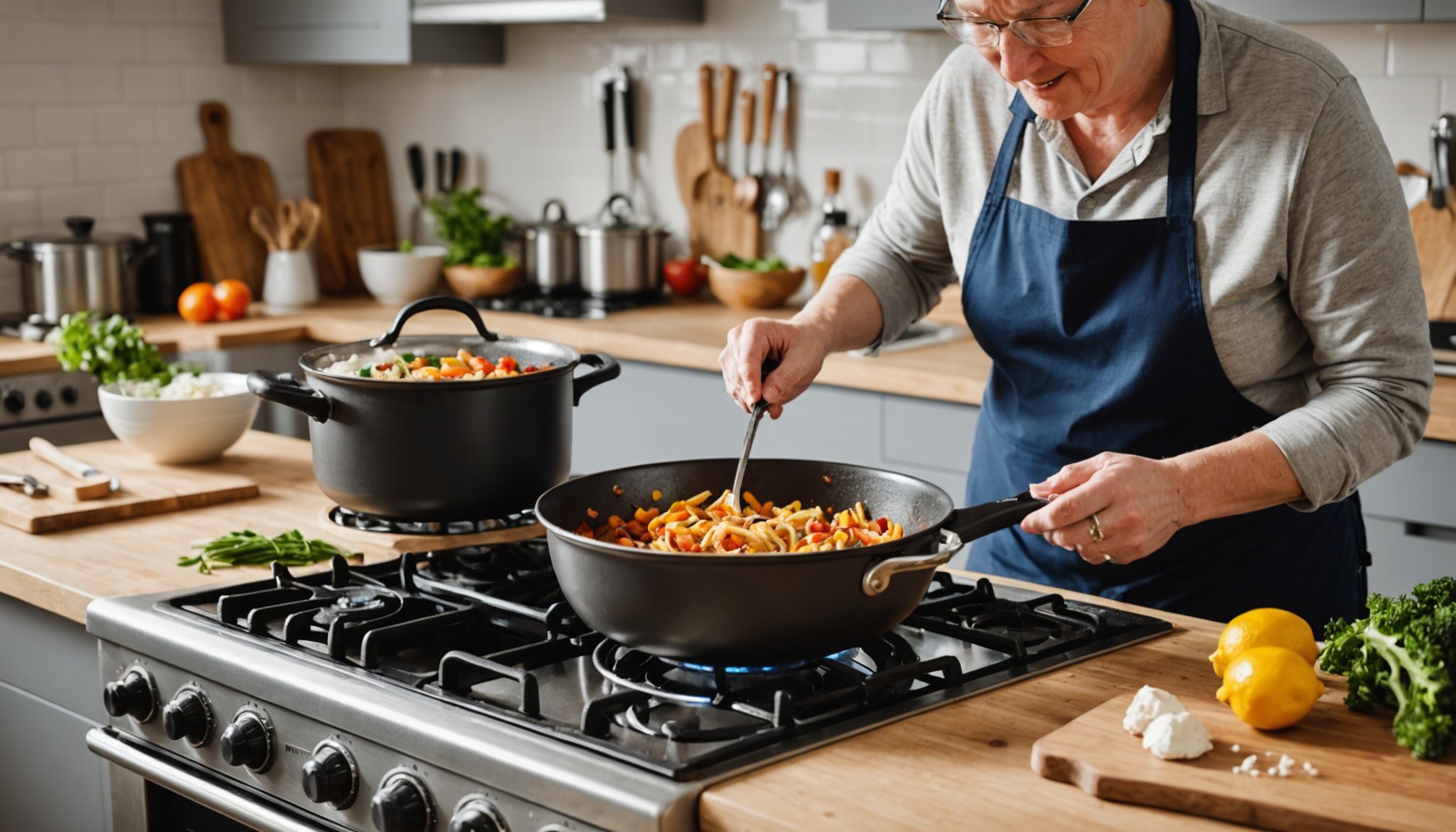Energy-Efficient Appliances
Switching to energy-efficient cooking appliances can significantly impact both your energy consumption and overall utility bills. In the UK, where kitchen appliances are a staple in every household, the advantages of opting for energy-efficient models are numerous. These appliances use advanced technology to reduce energy usage, resulting in lower emissions and a smaller carbon footprint, making them an eco-friendly choice.
There are numerous examples of top-rated energy-saving kitchen appliances available in the UK market. Induction hobs, for instance, heat pans more effectively and reduce heat loss compared to traditional electric or gas hobs. Similarly, convection ovens use fans to circulate heat evenly, speeding up cooking times and using less energy overall. Energy-efficient refrigerators and dishwashers are also excellent options, featuring enhanced insulation and smart sensors to optimise performance without unnecessary energy drain.
In parallel : Maximizing Solar Efficiency: The Best Panel Arrangement for Terraced Roofs in Reading
Investing in such appliances not only helps the environment but also offers substantial long-term cost benefits. Though the initial cost might be higher, the energy savings over time offset this expense significantly, providing excellent value in the long run. Households can enjoy reduced utility bills, greater appliance lifespan, and contribute to a greener planet — a win-win scenario for both the wallet and the world.
Optimal Cooking Techniques
Mastering cooking techniques for energy savings is crucial for reducing energy bills and enhancing efficiency in the kitchen. One of the simplest methods is to harness the power of proper heat management. Preheating ovens to the precise temperature needed before inserting food ensures that cooking begins immediately, minimizing wasted energy. It’s a small step with significant impact.
Also to read : Top Drought-Resilient Plants Perfect for Your UK Garden
Incorporating appliances like pressure cookers and slow cookers can further enhance maximizing cooking efficiency. Pressure cookers utilize steam and high pressure to cook food rapidly while conserving energy. Slow cookers, on the other hand, use low, consistent heat, perfect for recipes that don’t require high energy input, leisurely simmering ingredients to perfection while using minimal energy.
The benefits of batch cooking and meal prepping also extend beyond saving time. By preparing larger portions in one cooking session, you reduce the number of times the oven is used, thereby conserving energy. This practice not only saves money and electricity but also frees up time for busy individuals. Another advantage is the reduction of energy spikes, making it a savvy habit for those conscious of both their carbon footprint and utility expenses.
Residual Heat Utilization
Incorporating residual heat cooking into your routine offers a brilliant approach to energy conservation methods. By embracing the heat retained in ovens and stovetops after they are switched off, you can effectively reduce your energy consumption. For example, turning off the oven a few minutes before the timer runs out allows the residual heat to complete the cooking process. This technique is doubly beneficial as it not only saves energy but also prevents overcooking.
Maximizing heat retention in pots and pans is another simple yet effective method. Using lids while cooking traps heat more effectively, speeding up the process and conserving energy. Cast iron cookware also excels in retaining heat, continuing to cook food even after the burner is turned off.
In day-to-day life, practical examples abound. Consider cooking pasta: once boiling, switching off the hob and letting residual heat complete the cooking ensures perfectly al dente results. Similarly, when baking casseroles or roasting vegetables, turning the oven off ten minutes early and leaving food inside can achieve energy efficiency without sacrificing taste. These smart tips make heat management in cooking straightforward and rewarding, aligning perfectly with sustainable cooking habits.
Smart Cooking Practices
Embracing smart cooking habits is a pivotal step toward budget-friendly cooking and increasing overall kitchen efficiency. Consider the importance of lid usage on pots and pans. Lids trap heat and moisture, proving instrumental in reducing cooking time and energy use. By maintaining heat within the cookware, dishes are prepared faster, saving energy and preserving flavour.
For an inventive twist, cooking smaller portions can significantly impact energy savings. Smaller quantities heat more quickly and require less overall time on the burner or in the oven, consequently lowering energy consumption. This approach also minimizes the potential for leftovers, aiding in waste reduction.
The role of microwaves and induction cooking offers another layer of energy efficiency. These appliances use more targeted methods to heat food rapidly. Microwaves excel at reheating and cooking small portions with minimal energy drain. Meanwhile, induction cooktops directly heat pots and avoid dissipating heat into the surrounding environment.
By incorporating these smart practices, households can enjoy reduced utility bills while still indulging in delicious homemade meals. Adopting these cooking efficiency tips ensures both economic and environmental benefits, offering sustainable solutions for everyday meal preparation.
Timing and Cooking Methods
Effectively managing cooking time can significantly contribute to energy savings in the kitchen. Efficient cooking methods alongside thoughtful scheduling are key to minimizing energy overlap and reducing peak energy usage, both of which lead to lowering utility bills.
Daily meals shouldn’t just be about what’s on the menu, but how to prepare them while consuming the least energy. Planning cooking schedules ensures appliances are used optimally, preventing multiple devices from running simultaneously and creating unnecessary energy peaks.
No-cook meals are an innovative solution to incorporate into your routine, offering nutritional benefits without turning on the stove or oven. Salads or sandwiches made with fresh ingredients require minimal energy, making them a perfect choice for days focused on conservation.
Additionally, preparing efficient cooking methods such as using the microwave for reheating can save significant energy, as it heats smaller areas for shorter periods. Embracing techniques like parboiling vegetables before roasting them can reduce oven time, achieving the desired texture while cutting overall energy consumption.
Implementing these methods thoughtfully aligns with broader energy conservation goals, providing economic and environmental benefits. By being mindful of how you cook, it’s possible to make your cooking practices more efficient and sustainable.
Local and Seasonal Ingredients
The integration of local and seasonal ingredients into your cooking routine is not merely a culinary preference but a conscientious choice for energy-efficient practices. By choosing produce that is grown locally, you significantly reduce “food miles” — the distance food travels from farm to table, which in turn lowers greenhouse gas emissions associated with transportation.
Seasonal cooking also enhances energy savings. Ingredients in season naturally require fewer resources to grow and are fresher, often translating to shorter cooking times. This goes hand-in-hand with energy-efficient cooking practices.
For instance, in the UK, spring offers brilliant asparagus while autumn brings hearty root vegetables, perfect for stews and soups that can simmer on low heat. Opting for these seasonal recipes not only supports local farmers but provides economic benefits as well, as ingredients in season tend to be less expensive and of superior quality.
Embracing local and seasonal ingredients can lead to:
- Reduced energy consumption
- Lower utility bills
- Enhanced flavour and nutritional content
The benefits are clear; by planning meals around seasonal produce, you enjoy fresher ingredients while contributing to a sustainable future. These choices empower cooks to engage in energy-efficient practices with substantial impact.











